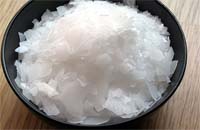Difference Between Epsom salt and Sea Salt
 Epsom salt and Sea Salt
Epsom salt and Sea Salt
We all use salts in our daily lives. It can be for cooking, in the form of cosmetics, or even for craft purposes. But not many know that there are different types of salt available. The major two types of salt available are the sea salt and Epsom salt. We also have some other varieties like table salt and kosher salt.
Sea salt is the salt that is got when sea water gets evaporated. It is usually in the form of crystals and is used for cooking and preparation of certain cosmetic products. Epsom salt is prepared by chemical processes and the major component is magnesium. It is usually used when there is a magnesium deficiency in the soil for gardening purposes. The anhydrous form of Epsom salt works best for plants.
In the market, sea salt is available in the forms of coarse grains as well as powdered and fine textured. This salt is used in cooking as it has many minerals like magnesium, iodine, and potassium. These are highly essential nutrients for the human body. Epsom salt has high contents of magnesium in it. It is used in bath salts due to the property that the salt gets absorbed into the skin. It is effective in reducing stress, draws out several toxins from the body, and is proved to treat several skin problems.
There are different varieties of sea salt available like pink, black, and brown sea salts. Some more costly varieties are the gray coloured ones. Sea salt is usually unrefined and retains the required chemicals. Epsom salt is available in the powdered form as well as gels.
Due to the presence of these minerals, sea salt has a refreshing taste and is lightly flavoured than the common table salt. Epsom salt also is edible in small quantities. Its flavour is not that refreshing as that of the sea salt.
Sea salt is often chunky and not very clear in appearance. Epsom salt crystals, which are heated and dehydrated, are very clear white crystals.
If sea salt is used in the purposes of cooking and preparation of cosmetics, Epsom salt has varied uses. Epsom salt is used in gardening for the soil of potted plants. The increased magnesium levels make the plants healthy and lively. It is also edible. So it is used as a coagulant in the preparation of Tofu. It is used for many treatments of the skin and other things like removing toxins, for aching limbs, and keeping the skin hydrated. The gel forms of Epsom salts are usually used in medicines.
Summary:
1.Sea salt is obtained from the evaporation of sea water. Epsom salt is obtained by chemical processes.
2.The major component of Epsom salt is magnesium while that of sea salt are iodine, potassium, and magnesium.
3.Sea salt is usually not clear and chunky in appearance. Epsom salt crystals turn white when heated and dehydrated.
4.Epsom salt has varied uses like in gardening and agriculture, body healing, preparation of medicines, and cooking. Sea salt is used mainly for cooking and preparation of cosmetic products.
- Difference Between Schizophrenia and Psychosis - March 7, 2024
- Difference Between African and Asian Elephants - March 7, 2024
- Difference Between Sunscreen and Sunblock - February 15, 2024
Search DifferenceBetween.net :
 Email This Post
: If you like this article or our site. Please spread the word. Share it with your friends/family.
Email This Post
: If you like this article or our site. Please spread the word. Share it with your friends/family.
3 Comments
Trackbacks
- Difference Between Table Salt And Sea Salt | Difference Between | Table Salt And Sea Salt
- Difference Between Salt and Iodized salt | Difference Between | Salt vs Iodized salt


In search of the difference between medicated soak salts… I walk 4-6 miles 6 days per week at my job… Recently my back has been bothering me and by the end of the night the pain level is high… I’ve noticed a difference between regular Morton natural Epsom salts and their Sport Rub version…
What should I be searching for in ingredients???
Thank You